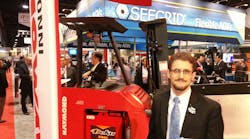My brain hasn’t been used much for lithium-ion energy storage, but ever since attending and returning from MODEX 2014 in Atlanta last week the topic has jolted me a few times. The first time was at the event itself, when this energy source came up during conversations with various lift truck and alternative power vendors. Not long before the show MH&L ran a product item from Flux Power Holdings, announcing it received approval to sell its 24 Volt LiFT Pack lithium battery for Class III Toyota and Raymond “walkie” lift trucks. This inspired interesting conversations, but I didn’t plan to do much with the information right away, since the popular conclusion seemed to be that lithium ion still isn’t ready for prime time in the U.S.
So this morning as I was catching up on my e-mails I read this in the latest edition of ForkliftAction News: “Publicly traded Flux Power has identified Class 3 forklifts as a key market for its motive power LiFT packs, which are designed for lead-acid battery replacement and new applications. … Flux Power may roll out a lithium-ion product for Class 1 forklifts in late 2014. … Flux Power says Arlan Purdy, product manager with Raymond Corp of Greene, New York, gave approval on 31 January for use of the 24v on Raymond’s Class 3 line. … Along with Raymond, sister company Toyota Material Handling USA (TMHU) of Columbus, Indiana makes the Flux Power technology available.”
This gave me a little memory jolt because Purdy was one of the people with whom I spoke about this energy source at MODEX. I combined fuel cells into the mix, asking for his take on their potential.“We've always supported our customers’ interests in energy storage technology and we will continue to do so, but our feeling is that widespread adoption of fuel cells would require a more robust hydrogen economy and infrastructure,” he said. “Lithium Ion batteries have some clear advantages in terms of energy density and charge and discharge rates. However, lithium batteries require a control system that adds cost and complexity, and that complexity introduces new challenges. We would want new technologies to match the reliability of the lead acid batteries we’re used to. If costs come down as projected, there may be some applications where lithium batteries make sense. We know that Europe is a little further along testing lithium batteries. That may be related to their higher labor costs. We think these kinds of regional differences will continue.”
At about the time we ran that product announcement on Flux, I got a similar assessment from Toyota’s Mark Faiman, product manager for their IC, GSC and AWP products.
“The biggest problem with lithium ion is getting the cost of the battery down,” he said. “People are working on a lot of different alternatives that might do it, but nothing short term. Same for fuel cells. They hold great promise but the fueling infrastructure is the issue.”
So while the forklift industry in the U.S. is focusing its energy on lead-acid-battery and propane-powered forklifts, you should remember when you’re considering your next purchase to ask about all forms of energy. You may spark a spirited conversation with your dealer. But while the OEMs they represent may be testing market readiness for this technology, don’t be disappointed if you get the same takeaway I got from Arlan Purdy at MODEX:
“Don’t focus too much on the battery or energy technology. What you really need to know is how that energy will provide the support needed to do the job most cost effectively. We’ve seen people who will emphasize the top speed of a lift truck but when we do application studies we find their real emphasis should be on acceleration, braking, lift and travel. Don’t reduce warehousing to a single metric.”
For more takeaways from MODEX see our report, 12 Booths that Rocked Modex 2014.




